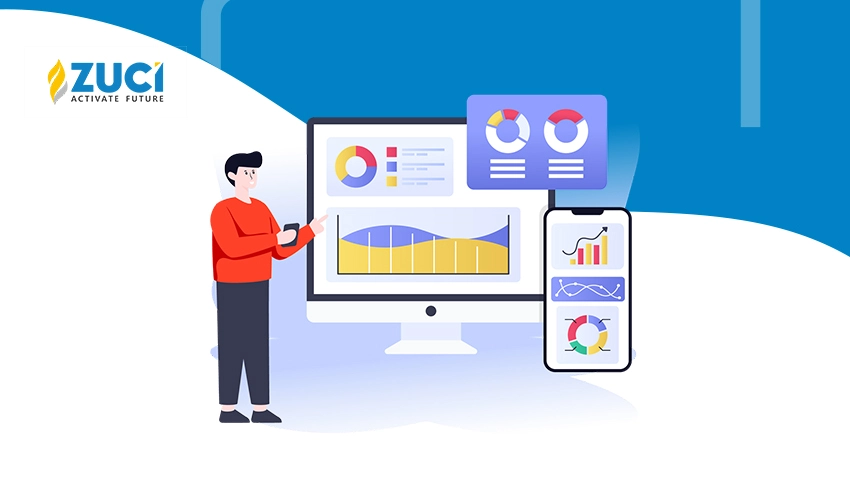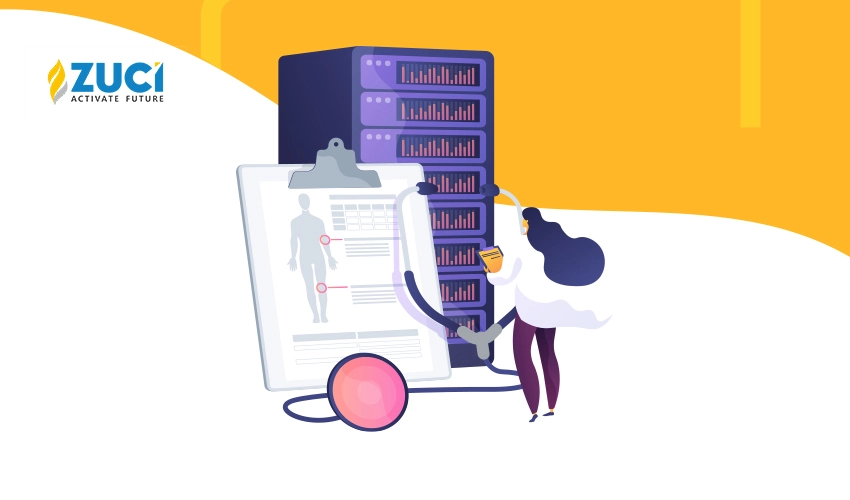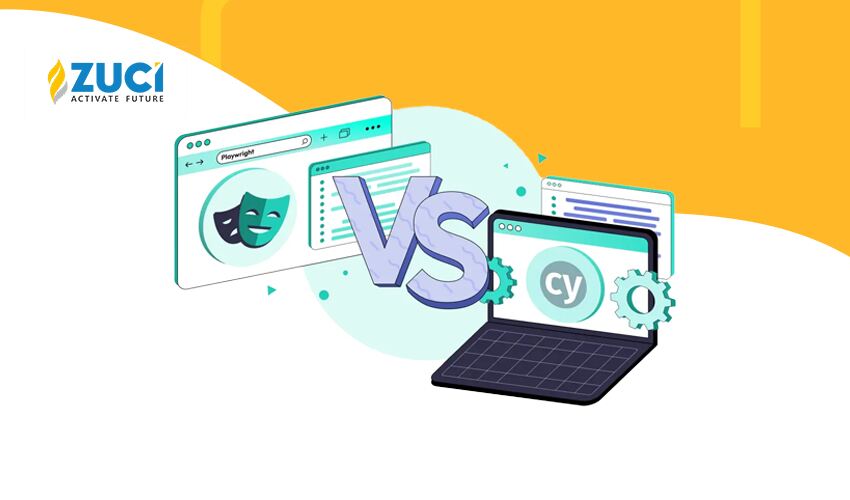Reading Time : 1 Mins
Integrated Command & Control Center: Why does Every Organization Need This?
I write about fintech, data, and everything around it
Have you ever imagined having a command & control center, right at your fingertips, where you could see an overview and complete 360-degree summary of your business operations in real-time? Well, today, it is no longer a need. It is a necessity. And this blog is to help you understand why every organization needs an Integrated Command & Control Center and the benefits of having one.
Have you ever seen the impressive command and control centers in movies, where huge screens are used to show all kinds of information, create real-time maps and monitor the entire kingdom? I have! I actually love TV shows about the US Army. The characters in those shows look like they really know what they’re doing. Everything runs smoothly when everything falls into place, and the commanders understand their troops’ positions, possible threats, and available resources. Similar is the situation for every business organization.
Being there with your team is the best way to gain insight and make an impact. But living and breathing the day-to-day operations of your business means there are instances where you’ll miss out on important motions, developments, and changes to the overall operational landscape.
And that’s when an effective 360-degree organization dashboard comes into the picture. A proactive dashboard like this informs the top stakeholders on various aspects, including how well the business performs, identifies problems, and predicts future operations – right on your browser or mobile, saving you countless hours of research time.
Every medium to a large organization has big data coming from outside and inside the organization. But the key question here is – how is the information getting captured? How is it being analyzed? And how is all this combined to give us a complete 360-degree understanding of organizational health? We answer them all.
The idea behind this content is to educate our readers about Strategic Business Intelligence (BI) and how it has evolved into providing rich data sets to create 360-degree organization dashboards, unlike anything we’ve ever seen before.
In this blog post, you will get an overview on:
- What is ICCC (Integrated Command & Control Center (ICCC)?
- Difference Between Command & Control in IC&CC
- Elements of an Integrated Command and Control Center
- Business Benefits of Integrated Command & Control Center
- Case Study: A Delivery Service
Ok, let’s get started!
What Is an Integrated Command & Control Center (ICCC)?
An Integrated Command & Control Center (ICCC) is a collaborative workspace where key decision-makers monitor and manage incident response activities in real-time, enhancing their situational awareness. The ICCC provides a single source of truth for all business operations across functions, irrespective of the location or department they represent. It equips organizations with the information necessary to make informed decisions. It can be used to manage both day-to-day operations, plan future projects, and predict emergencies.
The Integrated Command & Control Center (ICCC) serves as an enabler to make decisions by providing insights and intelligence through complex data sets processed at an aggregate level which provides statistics, graphs, or visual representations for:
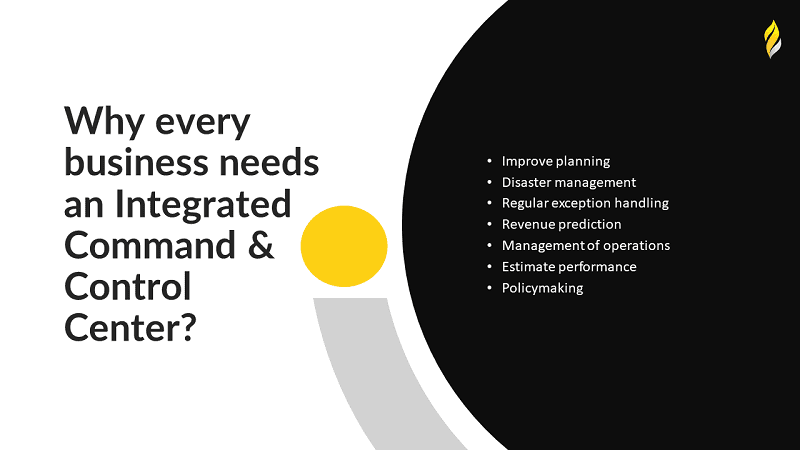
IC&CC (Integrated Command & Control Center) also allows decision-makers to see how single departments are operating compared to the whole organization – making it easier for them and other stakeholders to make decisions based on facts provided by this system.
Lastly, ICCC is not only for decision-makers. It provides everyone from different departments a holistic view of what is going on in their area and throughout the organization.
Difference Between Control & Command in ICCC
Since the dawn of human civilization, the objective of any organization has been to optimize resources and maximize profits. For this purpose, there are always two parallel functions in an organization: Control and Command.
In brief, the command is the decision-making function of management; control is a process by which some degree of predictability and order is achieved in an organization.
Command is a before-the-fact function:
An individual or a team issues orders in advance so that execution can occur as per plan. An individual or a team ensures that resources are available to execute plans. If required, changes are made at the planning stage itself, so that necessary resources can be acquired.
Control is an after-the-fact function:
An individual or a team tries to analyze the performance of an activity based on measurable parameters. If there is a discrepancy between the actual and expected performance, corrective action may ensure that similar discrepancies are not repeated. The actual performance can be compared with the planned or budgeted performance.
Example of Command & Control:
For example, if we are looking at the operations of a manufacturing company, the command and control process might look like this:
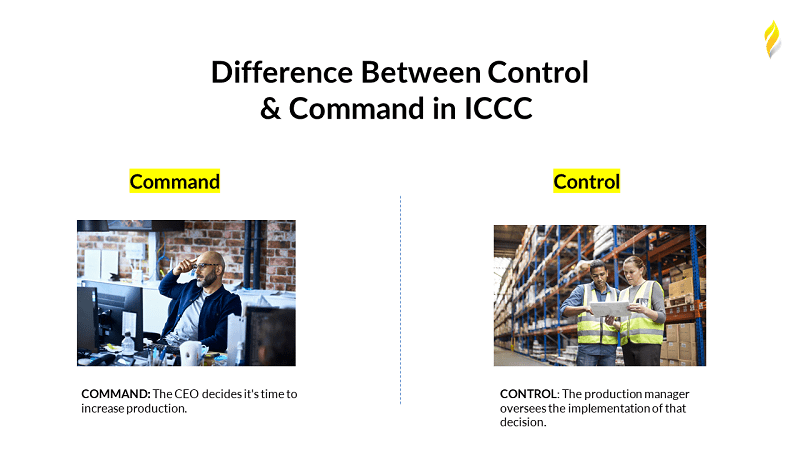
Now, let’s say you’ve got a security breach happening on your network. The IC&CC will be communicating with all parties involved—the network administrator responsible for fixing the problem and the security team responsible for finding out who caused it—and making sure that they are all on the same page.
On the other hand, an IC&CC will take charge of situations that require urgent and immediate action in a control situation. For example, let’s say there’s been an earthquake, and you need to assemble a rescue team quickly. The IC&CC will have already prepared for this by creating a template filled in with necessary information about where rescuers need to go and what their tasks will be when they get there. They’ll fill out this template with the most up-to-date information available from sources.
Elements of an Integrated Command And Control Center
Integrated Command and Control Centers are built to bring down data from all disparate systems to one data bank on a single platform. It was intended to act as an organizational dashboard where one can see steady progress at all times.
Considering the holistic structure of the integrated command and control center, we at Zuci Systems think command and control are critical of any well-run business. No matter what industry you’re in, command and control ensure that you have the data and tools you need to make the right decisions.
We have found that 5 operational elements should be considered when creating a command and control center:
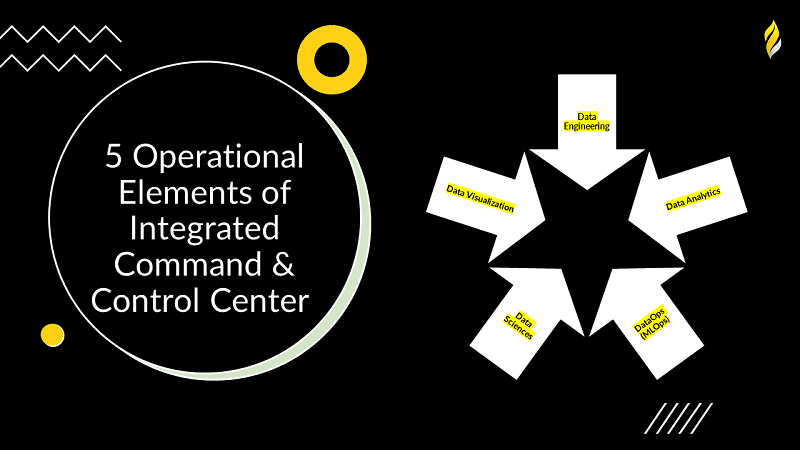
1. Data Engineering
The first and most important element of an Integrated Command and Control Center is data integration across different systems and solutions into one common data bank. In the old days, people collected data from disparate sources, manually processed it, and passed it on to the next stage. Nowadays, we have automated the process to save time and money.
There are three phases of data engineering:
- Storage of data consisting of Immutable Data Store (IDS),
- Extraction, loading, and transformation of data to use for analysis with data pipelines
- Analysis of data
To get started with Integrated Command & Control Center, building an Integration Center of Excellence (ICoE) is a must.
2. DataOps (MLOps)
Data operations are the primary function of the data department. It is concerned with taking all that data gathered by data engineering teams and creating actionable insights. This may involve using machine learning algorithms to analyze massive amounts of information and build predictive models that can be used to inform decisions made by decision-makers within the organization implementing the command and control center.
MLOps allows developers and engineers alike to collaborate on projects more efficiently by providing them with tools like version control to track changes over time.
3. Data Analytics
Once you have your data organized, you’ll use Data Analytics to answer complex questions with data science methods, data modeling, and ad hoc analysis techniques. You can also use it to find patterns in your data without knowing what you’re looking for ahead of time. This helps you make connections between seemingly unrelated things so you can discover new opportunities or problems to address.
Once the data is refined and converted into a usable form, data analytics helps enterprises derive actionable insights. For example, the companies can determine the days or months of the year their products have the highest demand to align their resources accordingly.
4. Data Sciences
Data science is one of the critical pillars of an ICCC. Data Science is a branch of science that focuses on more specific data analytics questions. In other words, data analytics is a subset of data science.
Data analytics gives insights and patterns, whereas data science answers specific questions. The task of a data scientist is to come up with questions, predictions, and forecasts, and an analytics person is to find answers to an existing set of questions.
For example, if there is a data set for ad clicks, data science will help determine the questions we need answers to (such as when the traffic is the highest?). Whereas data analytics will help analyze the data and give us the answer.
5. Data Visualization
Data Visualization is one of the operational elements of integrated command and control center. Data visualization refers to the creation of visual representations of abstract data. It typically helps to understand large chunks of data with ease.
Using data visualization tools helps make data more accessible without losing any essential information in the ICCC for quick and timely decisions.
Business Benefits of Integrated Command & Control Center
ICCC allows organizations to perform various applications from administration to real-time event handling based on concurrent data. The integrated command and control center intends to make fundamental functional changes, mid-course amendments, and prepare backup plans to enhance overall business agility and productivity.
Let’s look at some of the integral benefits of ICCC.

1. Built-in Intelligence
Integrating built-in intelligence in ICCC for large businesses eliminates redundancies from conventional systems providing more efficiency to business operations. Present-day integrated command and control centers are based on Artificial Intelligence (AI) and Machine Learning (ML), providing automated data through autonomous sensory and surveillance devices.
Characteristics like automatic risk detection, notifications handling, and predictive warning are all possible due to the built-in intelligence features of ICCC.
For example, suppose an unusual parameter (like fire or unauthorized activity) is observed. In that case, the risk detection systems can be activated to notify the Integrated Command & Control Center (ICCC) to take the necessary steps.
2. Proactive and Responsive
Response and management plans to any critical situation in a business are crucial elements for its smooth functioning. Integrated command and control centers provide proactive data, which after processing can be used as a performance indicator through various representations in graphs, stats, and visual formats. This information gives a 360-degree view of the business operations, and the management can use this information to take proactive measures and make informed decisions. This ensures the whole mechanism stays intact in an organized manner.
For example, ICCC can give decision-makers a holistic view of an ongoing process or project to understand real-time progress, estimated outcomes, and delivery times. The actionable insights can prepare them in advance and make the right decisions.
3. Lower Cost of Operations
Integrated command and control centers are considered the brain for businesses that perform several administrative tasks and ease down management. ICCCs features are known to control the cost of operation as:
- Early predictive warnings prevent large scale damage,
- Better connectivity in the workspace saves labor cost and time,
- Dynamic data from different sources and databases improves operations by making critical business decisions and optimizing production.
For example, ICCC enables enhanced collaboration between teams. Rather than coordinating and taking inputs from individual teams, people can get structured information from a centralized command and control center and take necessary steps. This can be helpful in project/program management.
4. Improved operational competence
The constant influx of data from different sources allows the detection of various inconsistencies in an organization which can be dealt with in time, reducing damage. The control center constructively manages the situation with quick troubleshooting in an emergency. This improves the operational competence of an organization.
5. Seamless workflow
ICCC connects different levels of an organization allowing seamless integration between assets, systems, sites, and people. Better connectivity also allows timely management and saves a lot of labor work, time, energy, and resources, ultimately enhancing the organization’s performance.
For example, ICCC enables the implementation of agile workflows and eliminates wastage of resources. Enhanced collaboration and streamlined processes help in reduced resource requirements and improve performance.
6. Enhanced security
The ICCC features constant monitoring that helps regulate security by avoiding possible threats with appropriate measures in time. It has regulations on access and control, maintaining data integrity and confidentiality with 24×7 access to designated individuals.
7. Better decision making
Informed decision-making is a vital part of an organization to work efficiently. Data solutions can enhance essential procedures and systems’ functioning to deliver optimal results. Also, data-driven decision-making based on critical information can make complex functionalities condense into sets of handy tasks that can be performed within restricted time frames.

Case Study: A Delivery Service
It is essential to have information on several segments in a delivery business, such as the location of parcels, parcels to be picked and shipped, queries, new sales, and much more. An integrated command and control center helped them bring all the disparate data and visualize it at once.
ICCC enabled them to have a 360-degree view of all the packages in a visualization. It also helped in seamless communications and helped teams prioritize the most critical tasks using visualizations like Pareto charts.
With a complete 360-degree view of all stages of their customers, they could close 30% more deals in their subsequent quarter. Most teams achieved their targets as their workflows were shortened and this helped team save time and resources.
The customer relationship management team gave personalized treatment to customers and helped them with their grievances. ICCC also reduced the customer waiting time and increased customer retention rates. For example, if there is any query, the customers respond within 3 hours.
Takeaway
In conclusion, every organization needs to have well-defined goals, a fixed strategy, and most importantly, a plan of action to achieve them. The Integrated Command & Control Center will help you reach your goals by providing you with the right information at the right time to make optimal decisions that will lead to success.
So, whether you are an SME or enterprise company, data tracking is the key to the success of your business. Schedule a 30-minute call and learn about Zuci’s Data Engineering Services to craft a single source of truth system for real-time data analytics, business reporting, optimization, and analysis.
Zuci Systems is designed to give organizations a birds-eye view of their operations so that you can quickly execute commands when necessary and put control measures into place to keep things running smoothly. Contact us today.
Related Posts


